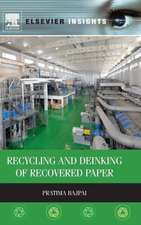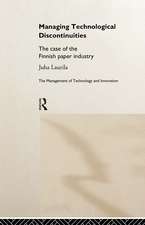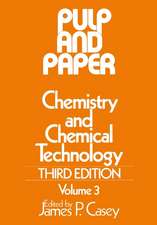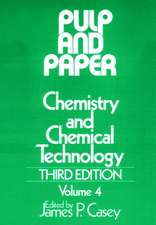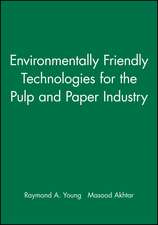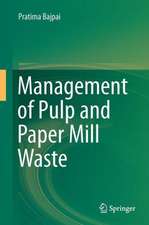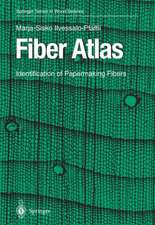Green Chemistry and Sustainability in Pulp and Paper Industry
Autor Pratima Bajpaien Limba Engleză Hardback – 8 iul 2015
The minimum impact mill does not mean "zero effluent", nor is it exclusive to one bleaching concept. It is a much bigger concept which means that significant progress must be made in the following areas: Water Management, Internal Chemical Management, Energy Management, Control and Discharge of Non-Process Elements and Removal of Hazardous Pollutants. At the moment, there is no bleached kraft pulp mill operating with zero effluent.
With the rise in environmental awareness due to the lobbying by environmental organizations and with increased government regulation there is now a trend towards sustainability in the pulp and paper industry. Sustainable pulp and paper manufacturing requires a holistic view of the manufacturing process.
During the last decade, there have been revolutionary technical developments in pulping, bleaching and chemical recovery technology. These developments have made it possible to further reduce loads in effluents and airborne emissions. Thus, there has been a strong progress towards minimum impact mills in the pulp and paper industry. The minimum-impact mill is a holistic manufacturing concept that encompasses environmental management systems, compliance with environmental laws and regulations and manufacturing technologies.
Preț: 645.60 lei
Preț vechi: 759.54 lei
-15% Nou
Puncte Express: 968
Preț estimativ în valută:
123.57€ • 134.27$ • 103.87£
123.57€ • 134.27$ • 103.87£
Carte tipărită la comandă
Livrare economică 22 aprilie-06 mai
Preluare comenzi: 021 569.72.76
Specificații
ISBN-13: 9783319187433
ISBN-10: 3319187430
Pagini: 258
Ilustrații: XVI, 258 p. 33 illus., 19 illus. in color.
Dimensiuni: 155 x 235 x 17 mm
Greutate: 0.56 kg
Ediția:2015
Editura: Springer International Publishing
Colecția Springer
Locul publicării:Cham, Switzerland
ISBN-10: 3319187430
Pagini: 258
Ilustrații: XVI, 258 p. 33 illus., 19 illus. in color.
Dimensiuni: 155 x 235 x 17 mm
Greutate: 0.56 kg
Ediția:2015
Editura: Springer International Publishing
Colecția Springer
Locul publicării:Cham, Switzerland
Public țintă
ResearchCuprins
1. General Background.- 2.Basic overview of Pulp and Paper Manufacturing.- 3. Environmental consequences of pulp and paper manufacture.- 4.Minimum Impact Mill Technologies.- 5. State-of-the-Art Pulp Mills.- 6. The Future.
Textul de pe ultima copertă
This book features in-depth and thorough coverage of Minimum Impact Mill Technologies which can meet the environmental challenges of the pulp and paper industry and also discusses Mills and Fiberlines that encompass “State-of-the-Art” technology and management practices.
The minimum impact mill does not mean "zero effluent", nor is it exclusive to one bleaching concept. It is a much bigger concept which means that significant progress must be made in the following areas: Water Management, Internal Chemical Management, Energy Management, Control and Discharge of Non-Process Elements and Removal of Hazardous Pollutants. At the moment, there is no bleached kraft pulp mill operating with zero effluent.
With the rise in environmental awareness due to the lobbying by environmental organizations and with increased government regulation there is now a trend towards sustainability in the pulp and paper industry. Sustainable pulp and paper manufacturing requires a holistic view of the manufacturing process.
During the last decade, there have been revolutionary technical developments in pulping, bleaching and chemical recovery technology. These developments have made it possible to further reduce loads in effluents and airborne emissions. Thus, there has been a strong progress towards minimum impact mills in the pulp and paper industry. The minimum-impact mill is a holistic manufacturing concept that encompasses environmental management systems, compliance with environmental laws and regulations and manufacturing technologies.
The minimum impact mill does not mean "zero effluent", nor is it exclusive to one bleaching concept. It is a much bigger concept which means that significant progress must be made in the following areas: Water Management, Internal Chemical Management, Energy Management, Control and Discharge of Non-Process Elements and Removal of Hazardous Pollutants. At the moment, there is no bleached kraft pulp mill operating with zero effluent.
With the rise in environmental awareness due to the lobbying by environmental organizations and with increased government regulation there is now a trend towards sustainability in the pulp and paper industry. Sustainable pulp and paper manufacturing requires a holistic view of the manufacturing process.
During the last decade, there have been revolutionary technical developments in pulping, bleaching and chemical recovery technology. These developments have made it possible to further reduce loads in effluents and airborne emissions. Thus, there has been a strong progress towards minimum impact mills in the pulp and paper industry. The minimum-impact mill is a holistic manufacturing concept that encompasses environmental management systems, compliance with environmental laws and regulations and manufacturing technologies.
Caracteristici
Thorough and in-depth coverage of Minimum Impact Mill Technologies Takes a look at the current technologies that have taken the pulp mills to the threshold of effluent closure Motivates the Mill personnel to incorporate new Minimum Impact Mill Technologies Describes some of the newest 21st century Fibre Lines practicing “Minimum impact manufacturing”


